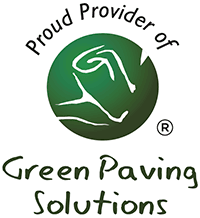5 Reasons to Utilize Green Paving Solutions
1) Save Energy

Solar reflective coatings are just one example of how Green Paving Solutions help save energy. Solar reflective coatings are designed for heat reduction of parking surfaces. The product is formulated with infrared reflective pigments to reduce solar absorption, increase reflectance and, ultimately, reduce cooling costs.
Additionally, the use of warm-mix asphalt versus hot-mix asphalt, a difference in temperature during production of up to 100 degrees Fahrenheit, cuts fuel consumption, decreases the production of greenhouse gases, and reduces emissions.
2) Reduce Pollution & Waste
There are recycled alternatives to both concrete and asphalt which, when utilized, conserve resources and reduce waste. For example, the use of fly ash – a recovered resource – reduces depletion of natural resources. It also reduces the energy-intensive manufacturing of other concrete ingredients, leading to savings in both energy usage and emissions of greenhouse gases.
Reclaimed Asphalt Pavement Content, or RAP Content, is the term given to removed and/or reprocessed pavement materials containing asphalt and aggregates. The utilization of high RAP has the greatest economical, environmental, and engineering impact in pavement recycling.
3) Save Costs
One example of how “Green” products cut costs is RePLAY™, an agricultural oil seal and preservation agent that can double the lifespan of existing pavement. RePLAY™, manufactured by Biospan Technologies, Inc., reverses the naturally occurring oxidation process while, at the same time, strengthening asphalt mix and sealing hairline cracks. RePLAY™ is comparable in costs to a traditional sealcoat application; however, it offers greater long-term benefits by reducing the need for repairs in the future.

4) Mitigate Stormwater Management Issues
Permeable pavers, pervious concrete, and porous asphalt alike are three different types of porous systems, which provide alternative solutions to stormwater management. Each promotes filtration and acts as on-site retention.
5) Qualify for Various LEED® Credits (Leadership in Energy and Environmental Design)
A LEED®-certified building can qualify for tax rebates, zoning allowances, and other city incentives. In addition to the many financial benefits of LEED® certification, LEED®-certified buildings provide a healthier and safer environment for occupants.
Alternatives such as pervious concrete, solar reflective coatings, and permeable paver bricks are environmentally friendly options which are also LEED® compliant.
Stay tuned for more info on Green products as well as a complete explanation of LEED® Certification coming later this month!




